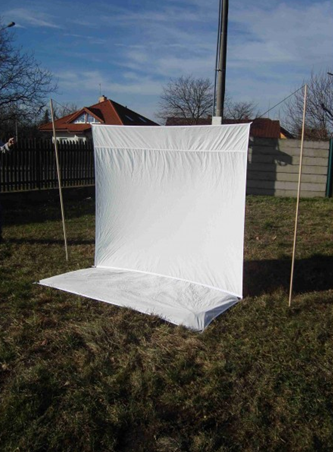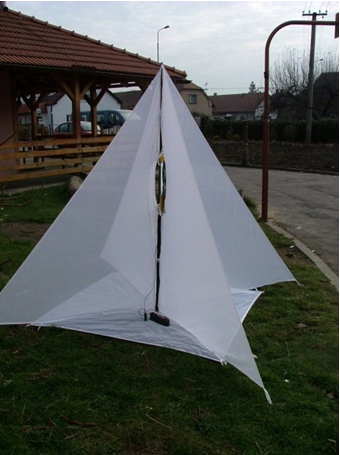7. Night Insects Collecting
01.12.2014
It is a warm summer evening at a porch near the forest. It is dark out there; the only light is provided by the light bulb of the house. Out of nowhere, a night butterfly starts to hit against the light bulb. The butterfly is irresistibly attracted to the light and it persists in hitting the bulb for a long time. This situation can be recalled by every one of us. Night insect collecting is built on such attraction to the light.
Night insect collecting using a light and cloth
The method of attracting insects to the light is used for collecting insects that are active during the evening and the night time. Between the basic equipment that is essential for night collecting belong a white (light) cloth, a light source, and an electric accumulator.
 |
| A cloth for the collection of night insects, model C |
This method consists of the act of lighting the white cloth surface using a light source. Insects see the light reflecting off the cloth and fly towards it. Insects then sit right on the cloth surface, or hit against the cloth and fall down to the ground.
Two basic variants of cloth for the collecting of night insects are being used in practice (depending on the number of lit walls).
- The first type has only one wall. A sheet is hung on a rope stretched between two trees or alternatively on a construction.
- The second type is often a three- or four-sided pyramid. The advantage of the latter is that the insect is attracted to a larger space and the cloth does not create any dead spot. The construction of a pyramid is frequently made from aluminum alloy. The spot for trapped insects is made by laying the lower part of the sheet on the ground.
 |
| A cloth for the collection of night insects, model A |
The light source
The light source is also a very important part of night collecting. We must pay attention to its output power, and to the spectrum of light luminosity, of which the UV radiance is a significant feature. The most convenient light bulbs are high-pressure light bulbs labelled as RVLX. Their luminosity and spectrum of radiance is of a high quality.
Light bulbs labelled as RVL made without thin white layer were previously used. The disadvantage of both types of these light bulbs is that they are mercury bulbs which are being replaced today by sodium and halogen bulbs. The minimal measuring discharge should be 125 W. The portable electric accumulator works very well as a source of electric energy. It is clear that cables for the connection of light bulbs with an energy source are needed.
Between the representatives of night insects which are trapped by light collecting belong Lepidoptera, namely Sphingidae, Noctuidae, Lasiocampidae, and Cossidae.
The choice of location and the time of collecting
The right choice of the locality for installation of the collecting device is one of the most important conditions for successful collecting. We primarily choose a location with no large lighting sources near to our collecting spot (street lighting, etc.). Right timing is also a very important feature.
The period around full moon is, for example, one of the worst times for night collecting (the amount of trapped insects is usually very poor). The most common period of time for night collecting is between dusk and dawn. Much better results of collecting are noted primarily during warmer nights when the temperature is more than 15 °C.
Some genres of butterflies can be found only at a certain time of year. So the season of the year is also an important condition for successful night collecting. That being said, we still need to know when the high season of the genre of insect we want to collect usually occurs.
In every season of the year there can be found in forests a wide amount of insects in different stages of evolution. Phenology is the study of periodic insect life cycle events and how these are influenced by seasonal and internal variations of climate, as well as habitat factors (such as elevation).
The names of phenology periods are early spring, spring, early summer, and autumn. For example, the Lymantria monacha cannot be found in June, because it occurs from the first half of July to the first half of August.
Author: David Mazáč
Categories
- Novelties
-
Preparation
- Black insect pins
- Stainless steel pins
- Minuten pins
- Plastic headed pins
- Label pins white
- Setting boards for Lepidoptera - LIMEWOOD
- Setting boards of BALSA
- Plastazote setting boards
- Portable suitcase for balsa spreaders
- Pergamine setting strip
- Foam bases
- Pinning block
- Mounting boards
- Sexual boards
- Mounting glues
- For microscopy
- Setting needle
-
Storing equipment
- Portable boxes
- Portable bilateral small suitcases
- Boxes with full lid
- Display boxes
- Entomological wooden display boxes
- Boxes without foam on the bottom for CARTON UNIT SYSTEM
- Carton UNIT trays for CARTON UNIT SYSTEM
- Boxes without foam on the bottom for PLASTIC UNIT SYSTEM
- Plastic UNIT trays for PLASTIC UNIT SYSTEM
- Entomolgical cabinets
- Entomological wooden drawers
- Entomological wooden drawers for CARTON UNIT SYSTEM
- Preservation
-
Field equipment
- Eclectors
- Exhaustor
- Killing fluids
- Syringes
- Butterfly nets and other equipment
- Stopper for killing bottles
- Fillings for killing bottles
- Malayse traps
- Polyethylene killing bottles
- Night field equipment
- Litter reducers
- Butterfly bags
- Aquatic nets
- Tree bark net
- Clap net (Japanese umbrella)
- Sweeping nets and other equipment
- Tree traps
- A Simple Raid Trap
- Other equipment
- Literature
